Easy Crusty Sourdough Rolls
Learn how to make these reader-favorite chewy and crusty sourdough rolls using a small amount of yeast and a special steam technique in your oven. Easy to make, with a great crust and soft interior.
This is the most popular of all my sourdough bread recipes. You’ll love how flexible this recipe is: make them for dinner tonight, sandwiches for lunch, or freeze them for later.
Crusty Sourdough Rolls

Ingredients
- 7 ounces active sourdough starter 1 ¼ cups / 200 grams
- 13 ounces bread flour 2 ½ cups to 3 cups / 370 grams
- 6.5 oz water ¾ cup plus 1 tablespoon / 185 grams
- ½ teaspoon sugar
- 1 ½ teaspoons salt
- ½ teaspoon yeast
Save This Recipe
You'll join my email list which you will love. And if you don't, unsubscribe in one click. ❤️
Instructions
- Mix all ingredients except salt and yeast. Combine the starter, flour, water, and sugar in a large bowl. Stir well, using your hands if needed to incorporate all ingredients. The mixture may look dry but will feel slightly sticky to the touch. Cover and allow to rest at room temperature for thirty minutes.

- Knead in the salt and yeast. Add the salt and yeast on top of the dough, and knead until smooth, stretchy, and elastic. (If using a bread machine, set it on the dough cycle. For a stand mixer, set it on low about 5 minutes. If kneading by hand, knead for about 10 minutes.) Check the consistency of the dough after a few minutes of kneading. It may seem sticky, but should clear the sides of the bowl and should not be too difficult to work with. If it seems very wet, add more flour a few tablespoons at a time.

- The first rise. When the dough is kneaded, cover it and put in in a warm place to rise between 60-90 minutes, until nearly doubled in size.

- Shape the rolls. Turn the dough out onto a clean counter or a cutting board. Prepare a baking sheet with parchment paper or oil and flour. Dust the top of the parchment with cornmeal. Divide the dough into 8 equal pieces, either by dividing into half, then quarters, then eighths, or by. using a kitchen scale. Shape the pieces into rolls by pinching the bottoms. Place on the cornmeal dusted parchment. Rub the tops with flour. Slash, if desired, using a lame or sharp knife.

- The second rise. Cover the rolls with heavily greased plastic wrap and let rise in a warm place for 45-60 minutes, until puffy. Towards the end of the rising time, preheat your oven to 450 degrees. Place one rack in the center, and one in the lower middle area. Place an empty baking sheet on the lower rack to get hot while the oven preheats.

- Bake with steam. When the oven has heated and the rolls have risen, pour one cup of water on the hot baking sheet to create steam. (It may buckle, this is ok.). Place the rolls inside and bake for 17-21 minutes, until browned outside. Cool rolls on wire rack for at least 30 minutes before serving.

Video
Notes
Nutrition
It only took me a million different tries to get this recipe right. I really hope you like them.
Sourdough Sundays Newsletter

Every Sunday evening I’ll send you a sourdough recipe to make that week, straight from my kitchen to your inbox.
And as a thank you for signing up, I’ll send you this e-book with beautiful printable recipes right away. Simple!
You will not be added to any other email lists or my daily newsletter. But if you’re already on my newsletter, you’re welcome to join and receive both.
Adding steam is the secret method that gives them the artisan look and nice high rise. We’re doing it the cheap way without a profession steam oven. Just pour some water onto a hot pan as your putting the rolls in to bake. Now they’ll have a steamy environment that lets them rise higher and faster.
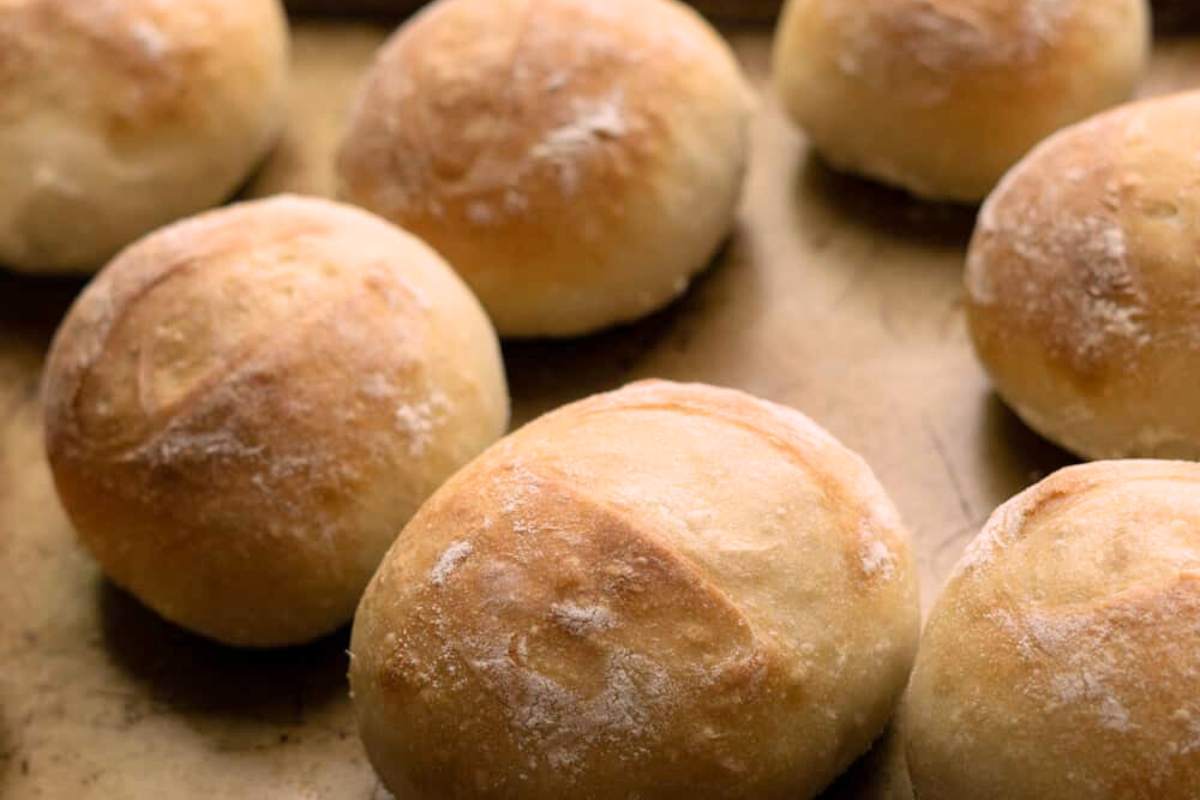
Getting the dough right is super important too. You want it slightly sticky but not so sticky that it’s hard to handle.
Tips for Success
Let them cool for at least 30 minutes; they’ll finish baking as they cool
You need to eyeball your dough. If it’s super wet, add flour. If it’s dry and crumbly add water. Just a little of each will make a difference.
The dough should clear the sides of the bowl but still feel slightly tacky.
Pinch the bottom of each roll to shape them, don’t squish down from the top.
This is one of the keys to a great oven spring. Don’t be afraid of this process.
Set up your oven like this, with a metal-rimmed baking sheet on a lower rack. (Do not use glass, or it will shatter!)
Ingredients and Equipment
Sourdough Starter: Should be active and bubbly, about the consistency of pancake batter
Bread Flour: Gives you chewier rolls with better structure
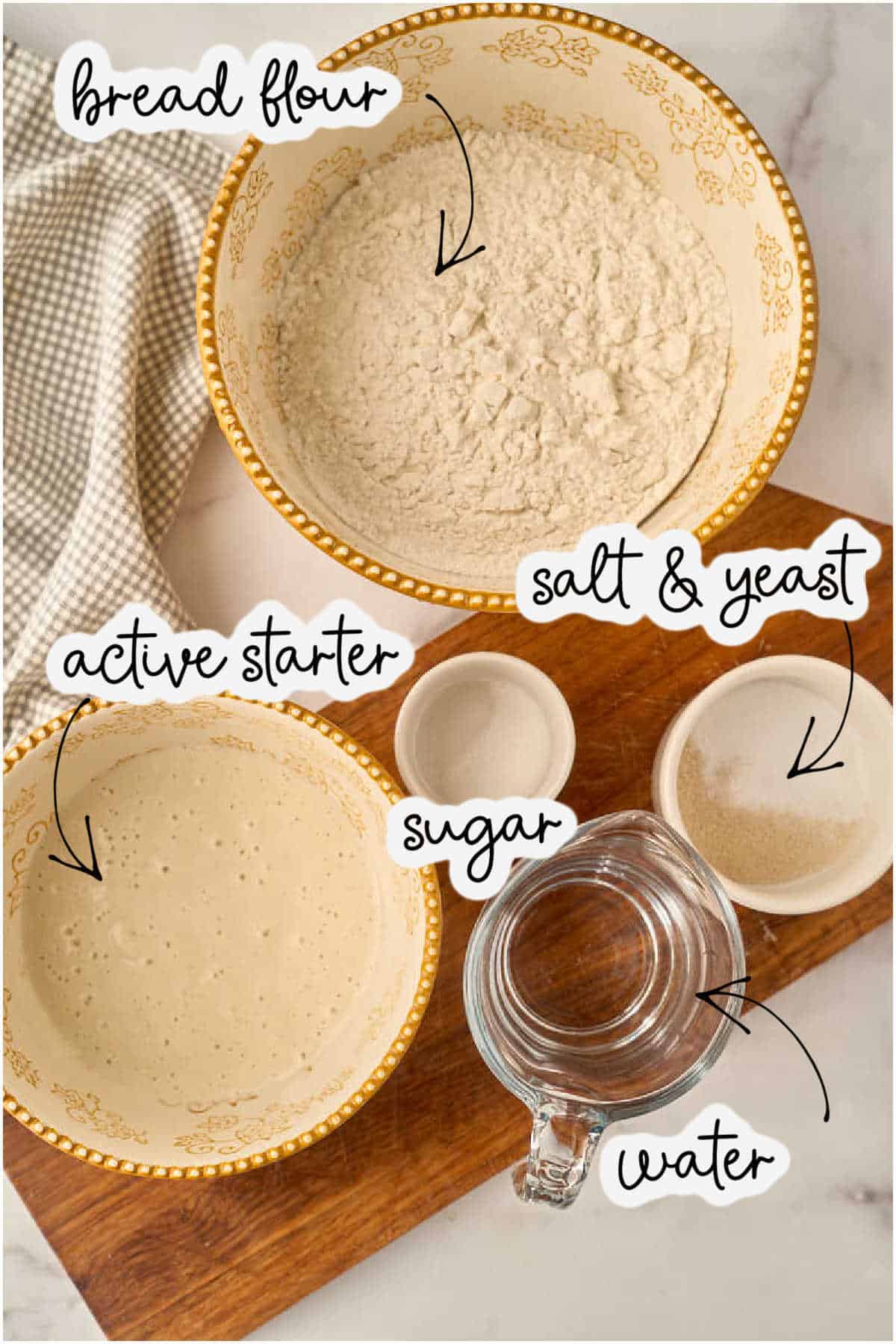
Digital Scale: Not required but really helps with consistency
Baking Sheet: You’ll need two – one for the rolls and one for creating steam
Parchment Paper: Prevents sticking and makes cleanup easier
Most sourdough starter is a thick, pourable liquid with the consistency of pancake batter. If yours is thicker or thinner, you will need to adjust the amount of water, so start with a lesser amount and add more slowly if needed.
Make It Your Own
- Try substituting up to 25% whole wheat flour
- Add a tablespoon of olive oil for softer rolls
- Divide into 12 pieces instead of 8 for dinner roll size
- No bread flour? All-purpose works too – just use a bit less water
Kneading Options
To knead by hand
Fold the dough in half, then punch it down. Stretch it out again, fold, and punch. Repeat this process for at least five minutes, until the dough is stretchy and smooth. You should be able to pull it flat without tearing it.
Kneading with a stand mixer
Place the dough in your mixer bowl with the dough hook and let it run on low for five to ten minutes.
Bread machine method
Simply add everything to the bucket and select the dough cycle. When the machine beeps, you’ll have a risen dough that’s ready to shape. I use this method the most.
Common Questions
You can reduce the water a bit and use all-purpose. They won’t be as chewy though. I really recommend bread flour!
You probably used all-purpose flour or measured it differently. Add some more flour. You’ll be okay.
Yes, an overnight rise in the refrigerator will work. Just shape them the next day, let them rise again, and bake.
I hope you come over to the sourdough dark side where everything is easy and works with your everyday life. This is a recipe you’ll make over and over.
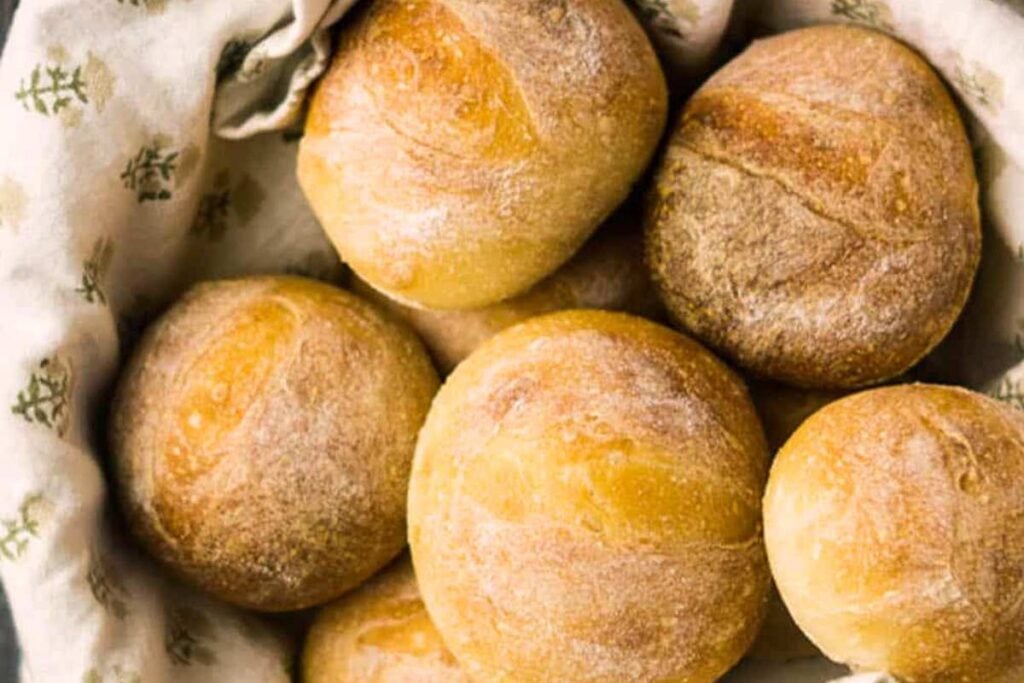
Love,



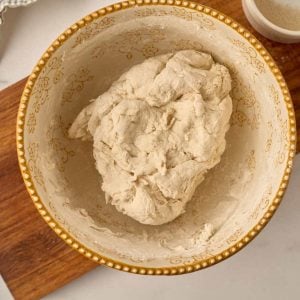
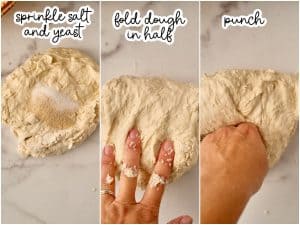

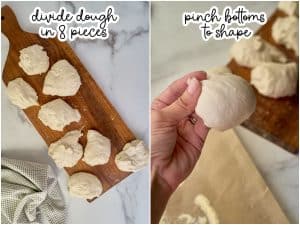
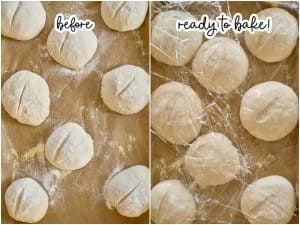
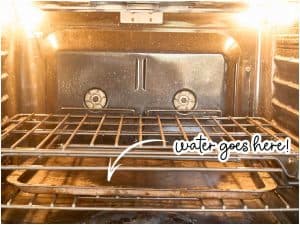
Could i use dry yeast?
yes, instant or active dry are both fine
I’ve been making these rolls for a while now and they turn out absolutely perfect every time! A great way to use up sourdough starter that seems a little reluctant to perform on its own too. Thank you so much for sharing this recipe. P.S I’m in Scotland where the flours are quite different but they still work perfectly (using bread flour here)!
hi norma! that’s great to know about your flour. I’m so happy you enjoy the recipe.
Can we use discard, or is it better to use active (fed and peaked) starter? Can’t wait to try them. Love the bread machine idea.
hi susan this recipe uses active starter
Are you able to double the recipe?
hi Kaitlyn, yes that will work perfectly 🙂
I want to make these for a holiday dinner. if I fully make them the day before how would I store and reheat? I saw good on the counter for 3 days so I’m assuming just leave them out but then how do I reheat them and for how long? will they still be just as good?
for the day before I would make them, let them cool, and store them. to heat them up, wrap in foil and bake for 5 minutes or so at 350. of course they are their very best if you make them the day of.
Yuuup, this is the one. They came out exactly as promised–chewy, crusty, and with well-balanced sourdough flavor. They paired perfectly with my bean soup. 🙂 Split in 8 pieces, they ended up as big as hamburger buns! Perfect mini-loaves. Next time, I’m thinking of doubling the recipe, so I can have some to put in the freezer.
Hi rain! thank you! and they freeze absolutely perfectly by the way! 🙂
Can I make this recipe if I have a gas oven?
yes, absolutely, the steam trick will work just fine in there
Has anyone made this recipe without the yeast?If so, would like to know a time line. Have been searching for a crusty roll recipe.
yes I do it alllllll the time. I allow 5 hours for the bulk rise and 3 after shaping. I start them super early in the morning. 🙂
Hi! I will be using this recipe this weekend! What is being used to bake the rolls?
hi do you mean the pan? just a rimmed baking sheet, I use a special “large” nordicware one that holds all of them.
Only 4 stars bc I haven’t made them yet but I am today! And you don’t have to use the second baking sheet for steam, bakers hack, throw some ice cubes in the bottom of the oven when you put the rolls in. They’ll create enough steam trust me!! Works for me every time 😊
I adjusted this recipe for a loaf instead of rolls. The rising time is the same but I bake at 425° for 20-22 minutes. It’s great sliced as sandwich bread. (The rolls are awesome too!)
hey dot! I truly love this idea because I love crusty sandwich bread. thanks so much for letting me know:)
Easy Peasy! First time making this recipe. Love it!
They look beautiful! wish I could show you.
Hey Lin, that’s so wonderful to hear! I’m so glad you loved the recipe. I bet your rolls turned out beautiful, wish I could see them too! If you ever have any questions or try another recipe, I’d love to hear how it goes. Happy baking
Wonderful recipe! Great flavor and such a tender texture while maintaining that crusty exterior. This was the recipe I’ve been searching for. Thank you!
Hey Scarlett, thank you so much! I’m so happy you found the recipe you were looking for. Enjoy your baking!
This is a wonderful recipe! Thank you for sharing it. These are wonderful hamburger buns and hoagie rolls too. I like having one recipe I can go to, to make different sourdough breads!
Hey Kelly, thank you so much! I’m so glad you love the recipe and find it useful for different types of bread. Using one recipe for multiple things makes baking so much easier! Happy baking!
My 1st time making rolls using active starter and they turned out perfect! I will be making these again. Thank you!
Hey Kaylene, that’s wonderful to hear! I’m so glad your rolls turned out perfect on your first try. There’s nothing better than the smell of fresh sourdough baking! Thank you for trying the recipe, and I hope you enjoy making (and eating!) them again. Happy baking!:)
The best sourdough rolls ever! I doubled the recipe and made 15 rolls. I baked half and froze half after the 2nd rise. I would highly recommend freezing as they baked up absolutely perfect! I took them out of the freezer and they were defrosted within a few hours. I kept them in the refrigerator until an hour before dinner, then put them in a warm place to rise a bit. Baked at 400 for 15 minutes without the water tray (I had chicken in the oven) and they were crusty and perfect! Thank you for this recipe!!
Hey Linda, thank you so much for your wonderful comment! I’m happy to hear these rolls turned out so perfectly for you. I’m so glad you enjoyed the recipe, and I really appreciate you sharing your process. Happy baking!
Thank you so much for sharing! I wanted to try a different kind of dinner roll and I’m so glad I found this! I’ve started using 00 flour and yeast from Italy. Little side note, I went to Europe for 2 weeks and had no digestive issues so when I came home, it started up again. Anyway, I added 25g more flour because it’s considered like an all purpose and followed your recipe! They came out perfect!! Thanks again!!
Hey Maureen, so glad they turned out perfect for you! Thanks for sharing your tweaks, I love hearing how you made it your own!
I’m excited to try this recipe. Is it possible to double it?
Yes, definitely! The only issue is you need two racks for one pan of rolls (on for the steam, one for the rolls) so it takes a little more time
I cannot possibly overstate how delicious and easy these rolls were to make. I did start making them a bit too late in the day, so after I had shaped the rolls, I covered the pan and let them cold proof in the fridge overnight before taking them out and letting them sit at room temperature for an hour prior to baking. They each are like an individual loaf of sourdough bread, so perfectly crispy on the outside while soft and chewy on the inside. I definitely will be making more for the holidays, and trying them out with rye and wheat flours for some variation.
hi Sarah! this warmed my heart! so happy you loved them, and enjoy your holidays 🙂
These were amazing, my first sour dough bread attempt; I appreciated the helpful tips! I plan on making again very soon! Thank you!
These were so yummy! exactly what I was hoping for. I substituted the sugar for honey and they turned out great. Thank you for sharing this recipe with us. ♡
Hi Rebecca,
I’m so happy to hear they turned out just how you hoped. Thanks for giving the recipe a try and sharing your experience!
Way to much salt, I doubled the recipe and we could not even eat these. Might be a good recipe if you cut the salt in half.
hey Shirley I’d double check your measurements. these really are not any saltier than any other bread. sometimes if you hit the 2x button the grams do not double. 🙂
I use the bread machine option, adding water and starter to the bottom of the bowl, then flour and the rest on top. After the bread machine does its thing (1 1/2 hours) I divide the dough in two and form into baguettes.
I also do an herb option, grinding a tablespoon of dried herbs (parsley, sage, rosemary, thyme, winter savory and oregano, about equal portions except less thyme), 1/2 tsp each of granulated onion and garlic. Comes out great.